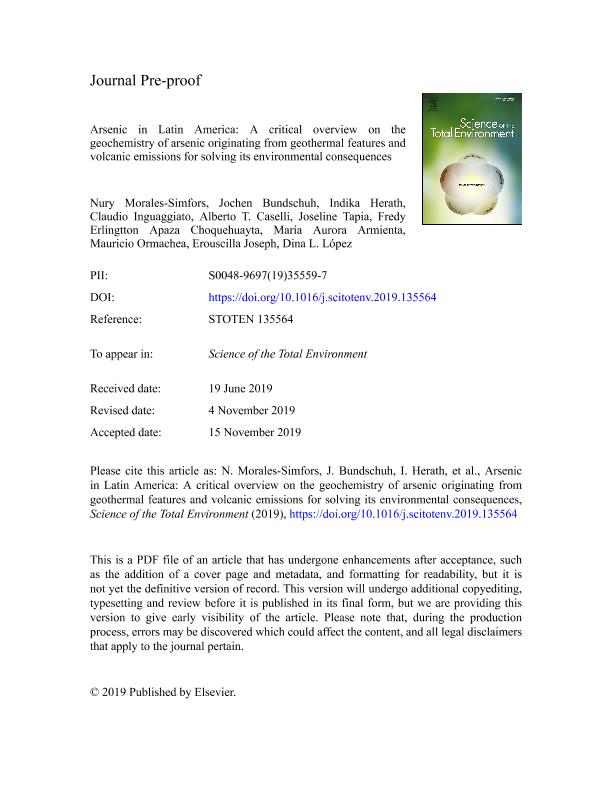Artículo
Arsenic in Latin America: A critical overview on the geochemistry of arsenic originating from geothermal features and volcanic emissions for solving its environmental consequences
Morales Simfors, Nury; Bundschuh, Jochen; Herath, Indika; Inguaggiato, Claudio; Caselli, Alberto Tomás ; Tapia, Joseline; Choquehuayta, Fredy Erlingtton Apaza; Armienta, María Aurora; Ormachea, Mauricio; Joseph, Erouscilla; López, Dina L.
; Tapia, Joseline; Choquehuayta, Fredy Erlingtton Apaza; Armienta, María Aurora; Ormachea, Mauricio; Joseph, Erouscilla; López, Dina L.
 ; Tapia, Joseline; Choquehuayta, Fredy Erlingtton Apaza; Armienta, María Aurora; Ormachea, Mauricio; Joseph, Erouscilla; López, Dina L.
; Tapia, Joseline; Choquehuayta, Fredy Erlingtton Apaza; Armienta, María Aurora; Ormachea, Mauricio; Joseph, Erouscilla; López, Dina L.
Fecha de publicación:
05/2020
Editorial:
Elsevier
Revista:
Science of the Total Environment
ISSN:
0048-9697
Idioma:
Inglés
Tipo de recurso:
Artículo publicado
Clasificación temática:
Resumen
Geothermal fluids and volcanic emissions are important sources of arsenic (As), resulting in elevated concentrations of As in ground-, surface-water and soil, which may adversely affect the environment. Arsenic originating from geothermal features and volcanic activities is common in Latin America forming a serious threat to the livelihoods of millions of people. This review attempts to provide a critical overview of the geochemistry of As originating from these sources in Latin America to understand what information exists about and what future research needs to be undertaken. This study evaluated 15 countries in Latin America. In total, 423 sites were characterized with As originating from geothermal sources, mostly related to present volcanic activity (0.001 < As<73 mg/L, mean: 36.5 mg/L) and the transboundary Guarani Aquifer System (0.001 < As<0.114 mg/L, mean: 0.06 mg/L). Many of the geothermal systems and volcanoes discussed in this study are close to densely populated cities, including Bogota, Managua, San José, Guatemala City and Mexico City, where total As concentrations in natural ground- and surface- water exceed the safe drinking water guideline of 0.01 mg/L, recommended by the World Health Organization (WHO). However, the wide geographical occurrence of As in geothermal fluids and volcanic emissions of this region is by far not fully understood, so that development of geographical maps based on geographic information system (GIS) is an urgent necessity to understand the real nature of the problem. The assessment of environmental risks and the potential impacts on human health both inadequate and scarce and hence, these gaps need to be addressed by future research. The present holistic assessment of As originating from geothermal features and volcanic emissions would be a driving force to formulate a plan for establishing a sustainable As mitigation in vulnerable areas of Latin America in the near future. An assessment of the geochemistry, mobility and distribution of As would augment the effectiveness of the plan.
Archivos asociados
Licencia
Identificadores
Colecciones
Articulos(IIPG)
Articulos de INSTITUTO DE INVESTIGACION EN PALEOBIOLOGIA Y GEOLOGIA
Articulos de INSTITUTO DE INVESTIGACION EN PALEOBIOLOGIA Y GEOLOGIA
Citación
Morales Simfors, Nury; Bundschuh, Jochen; Herath, Indika; Inguaggiato, Claudio; Caselli, Alberto Tomás; et al.; Arsenic in Latin America: A critical overview on the geochemistry of arsenic originating from geothermal features and volcanic emissions for solving its environmental consequences; Elsevier; Science of the Total Environment; 10; 4; 5-2020; 456-479
Compartir
Altmétricas



